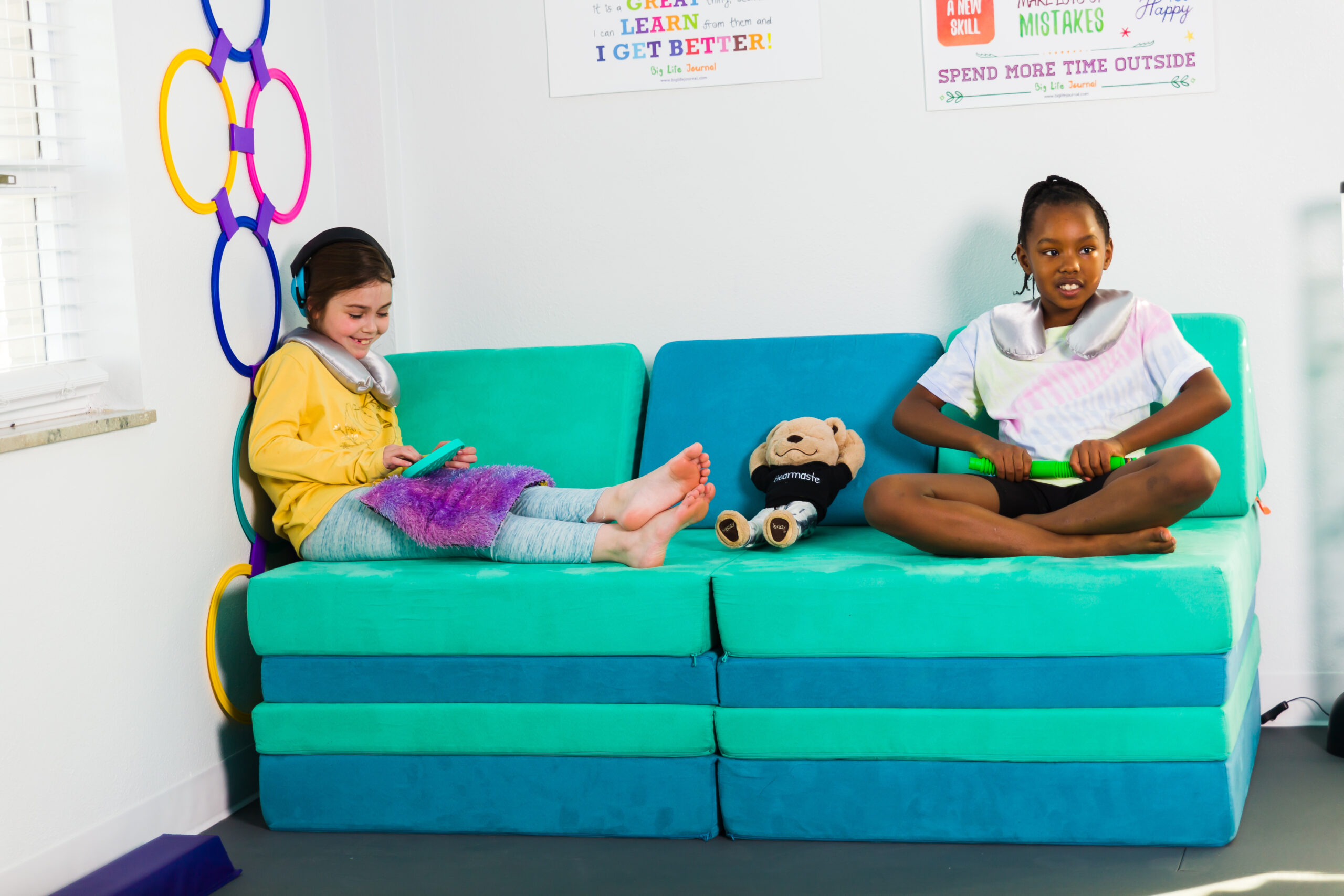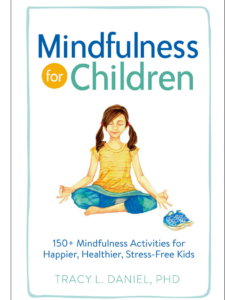
What is mindfulness for kids?
Mindfulness or paying attention with the senses, improves your child’s brain and body, by helping him build awareness and slow down. It is a set of activities that help you focus and direct your mind. Mindfulness means focused, sustained attention, in a non-judgemental manner, to the here and now. For children, it is paying attention, with your senses, in a kind way, so you can choose your behavior. Being mindful involves using your five senses to pay attention in the present moment. The awareness that mindfulness creates allows your child to pick healthier coping options.
What does the practice of it look like?
Mindfulness can take many forms. It can be a yoga practice, breath work, eating, coloring, or even hanging upside down. All mindfulness practices share a focus on sharpening attention and building self-regulation skills to handle challenging situations. Some activities, like the ones offered in our aerial yoga classes, add empathy, kindness, and gratitude as well. When these skills are intertwined with mindfulness it has been referred to as the science of happiness. Simple practices of the kind offered at Mindful Child can enhance well-being and increase happiness. These activities add mindfulness principals to everyday life so that it can be incorporated into daily activities such as eating and brushing your teeth.
Why Mindfulness for Kids?
In today’s world, children and teens have less than optimal physical and mental health. Children are overwhelmed with the constant input from digital devices and do not have the coping skills to manage their emotions. Children also have poor nutrient intake and academic pressures that have resulted in a significant increase in childhood stress in the United States. Research has shown twenty-five percent of children in the United States are suffering from Anxiety. Knowing how to deal with stress and anxiety is not a skill that children are born with, but one they learn with daily practice. Given the pressures that children are facing, mindfulness is fundamental to enhance emotional balance and to protect them from the harmful consequences of stress. Implemented in a consistent manner, mindfulness can address stress at the very core of the problem and not just treat the symptoms associated with it.
Here are some of the recognized benefits that mindfulness can provide for your child:
- Executive Function
- Cognition
- Mental Health
- Well-Being
- Learning
- Physical Health
- And much more
How do you Teach it to Kids?
The approach to teaching children is always different from that of adults. It is important to teach in a manner that includes movement, fun, and play so children are engaged. Aspects of fun and play should be present when teaching mindfulness to children. Children learn through their senses and enjoy activities that are sensory-based. They also love using their senses and mindfulness to eat a healthy snack. Attention to your senses keeps you in present moment. Your brain focuses on the mindfulness activity alleviating worry and rumination. Adele Diamond, professor of neuroscience, found that when we engage in activities, we find enjoyable, our brain produces neurotransmitters that get our brain ready for peak performance. This means children’s mindfulness activities should be enjoyable, full of movement, multi-sensory and play-based!
How Does it Work?
In recent years, research had shown that a consistent mindfulness practice can change the function and the structure of the brain. Science even details which parts of the brain are affected by mindfulness practice and how these beneficial changes can help our children. Mindfulness can enhance the development of your child’s brain and should be an important part of every child’s day. Science tells us it only takes 10 minutes of mindfulness practice a day to reap the benefits of mindfulness.
- Mindfulness can outperform medication. Mindfulness has been shown to grow grey matter in regions of the brain, which are responsible for executive function, higher level cognitive skills needed to regulate behavior.
- Brain imagining techniques have illustrated positive changes in brain structure and activity after participation in mindfulness techniques. The images indicated increased blood flow and a thickening of the cerebral cortex in areas associated with attention and emotions.
- Sara Lazar, a neuroscientist at Harvard Medical School, research demonstrates that the cortex shrinks as you age, but the prefrontal cortex of 50-year-old mindfulness practitioners had the same amount of gray matter as 25-year-olds. This was evident for individuals who had been practicing mindfulness for only eight-weeks. Just imagine the brain benefits children’s brains are receiving from starting a mindfulness practice early in life.
Create a Mindfulness Space at Home:
While it is not necessary to have a mindfulness space, it can be helpful to have a calming space for children to slow down and practice mindfulness techniques. Here are a few tips for creating a mindfulness space at home:
- Find a clutter free, small area that you can stand, sit, or lay down in. The space should be free of digital distractions and comfortable.
- Practice breathing slowly in and out through the nose. Begin with 3 breaths and then work to your way up to at least 10 breaths. Breathe all the way down to the belly.
- Lighting is important. The space should be dimly lit and contain a natural light source. Science tells us amber light can be calming and help with sleep.
De-stressing is a personal thing
Using mindfulness to de-stress requires you to discover how to best quiet your mind and relax your body. The single most important thing to do is to create time in the day – a 10 minute minimum is all that is needed to build the calming pathways in the brain. This window of time can expand over time , but is important that you actually start by spending the time practicing mindfulness each day.
Pick your favorite activities
It doesn’t matter what you do, but when your mindfulness practice is over, you will know it working as you and your child will feel calmer, relaxed and happier. Some families exercise with gentle yoga poses, some use guided meditations, some walk and use the senses to be mindful – find what works for you and your family, and make sure you do it daily for at least 10 minutes. Brain pathways and health habits are built by daily practice; if you don’t use mindfulness, you will lose it.
Stress-Relieving Strategies
- Art. Color a mandala.
- Deep breathing. Make a bubble mountain. Don’t have a straw, water and dish soap? No worries. Take a few elevator breaths, lay on the ground one hand on your heart, one on your stomach, and take ten deep breaths.
- Exercise. Do yoga poses in an aerial hammock or on the ground. Going upside down can calm the nervous system. Be sure to include a child’s pose or down dog pose and don’t forget to breathe.
- Meditate. Listen to a guided meditation.
- Incorporate mindfulness into mealtimes by adding a mindful fruit or dessert exercise.
- Be a tree. Practice balancing on one foot, in tree pose, while you notice what you see, hear, feel, and smell. Don’t forget to do the other side to keep the brain and body balanced.

Mindfulness at Mindful Child
At Mindful Child, mindfulness is an important part of our classes and therapy. It is what sets us apart from other aerial studios and occupational therapy clinics in the Kansas City area. Our aerial yoga practice is multifaceted, with children receiving physical and mental health benefits due to our focus on mindfulness. Science demonstrates that a practice of mindfulness for as little as 10 minutes a day can change the structure of the brain. That translates to enhanced self-regulation, and calmer, happier children.
Need more fun and therapeutic activities for the little ones in your life? Want to go deeper into the function of mindfulness? Get my book, Mindfulness for Children, it is packed full of engaging mindfulness activities for your entire family. We also provide occupational therapy for kids in Prairie Village and have aerial yoga classes for all ages.
Our aerial yoga summer camps are online and ready for sign-up. We have lots of options and all of our camps include a mindfulness component. We also have weekly aerial yoga classes.
References
Daniel, T. (2018). Mindfulness for Children: 150+ mindfulness activities for happier, healthier, stress-free kids. New York, New York: Simon and Schuster.
Keng SL, Smoski MJ, Robins CJ. Effects of mindfulness on psychological health: a review of empirical studies. Clin Psychol Rev. 2011 Aug;31(6):1041-56. doi: 10.1016/j.cpr.2011.04.006. Epub 2011 May 13. PMID: 21802619; PMCID: PMC3679190.
Lykins E, Baer RA. Psychological functioning in a sample of long-term practitioners of mindfulness meditation. Journal of Cognitive Psychotherapy: An International Quarterly. 2009;23:226–241
Sevinc G, Hölzel BK, Hashmi J, Greenberg J, McCallister A, Treadway M, Schneider ML, Dusek JA, Carmody J, Lazar SW. Common and Dissociable Neural Activity After Mindfulness-Based Stress Reduction and Relaxation Response Programs. Psychosom Med 2018 Jun;80(5):439-451.
Greenberg J, Romero VL, Elkin-Frankston S, Bezdek MA, Schumacher EH, Lazar SW. Reduced interference in working memory following mindfulness training is associated with increases in hippocampal volume.Brain Imaging Behav. 2018 Mar 17.
